|
setSC-Hemitomes_congestum-2
|
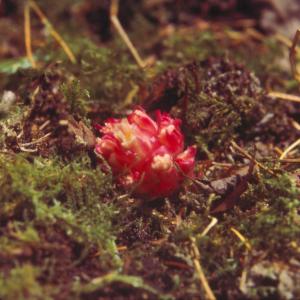
|
Sometimes Hemitomes congestum is rose rather than pink in color. It grows in the leaf litter of conifer forests from central California to Washington. The redwood belt in California is a good place to look for it, but it probably grows on fungi in the leaf litter not of redwoods, but of conifers that grow with the redwoods.
Return to the Hemitomes congestum page or the Parasitic Plant Index.
|
copyright: Carlquist, BSA
license: http://images.botany.org/index.html#license |
Image
|
Parasitic Plants

|

|
|
setSC-Hemitomes_congestum-3
|
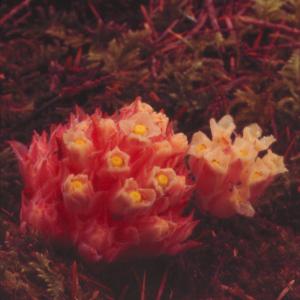
|
Here are two plants of Hemitomes growing next to each other--the large one is rose-colored, the smaller one is more nearly white.
Return to the Hemitomes congestum page or the Parasitic Plant Index.
|
copyright: Carlquist, BSA
license: http://images.botany.org/index.html#license |
Image
|
Parasitic Plants

|

|
|
setSC-Hemitomes_congestum-4
|
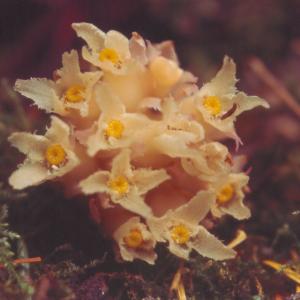
|
Seen from above, the flowers of Hemitomes congestum have four, sometimes five petals (united at their bases) which are fringed and curve outwards. The yellow stigmas are prominent in these flowers.
Return to the Hemitomes congestum page or the Parasitic Plant Index.
|
copyright: Carlquist, BSA
license: http://images.botany.org/index.html#license |
Image
|
Parasitic Plants

|

|
|
setSC-Hemitomes_congestum-5
|
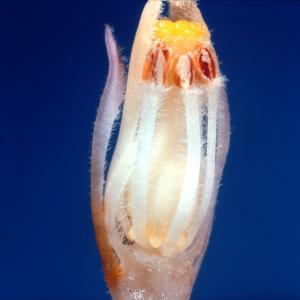
|
A flower of Hemitomes congestum with two of the petals removed so that the parts of the flower are visible. From top to bottom: the shiny yellow stigma, surrounded by the anthers, now open and shedding pollen; the hairy filaments on which the anthers are borne, and, at the bottom, the knob like nectaries, structures on the ovary that secrete nectar.
Return to the Hemitomes congestum page or the Parasitic Plant Index.
|
copyright: Carlquist, BSA
license: http://images.botany.org/index.html#license |
Image
|
Parasitic Plants

|

|
|
setSC-Hemitomes_congestum-6
|
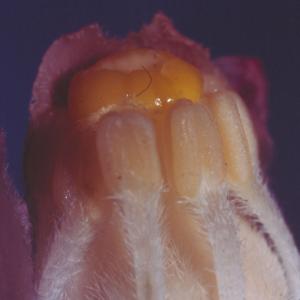
|
The upper portion of a flower of Hemitomes just as it opens reveals that the anthers are still closed, but the yellow stigma is sticky and looks receptive. If this is true, the flower would have to be pollinated by pollen from another flower. That's a way in which cross-pollination between plants could be achieved. Nobody knows what insect pollinates Hemitomes.
Return to the Hemitomes congestum page or the Parasitic Plant Index.
|
copyright: Carlquist, BSA
license: http://images.botany.org/index.html#license |
Image
|
Parasitic Plants

|

|
|
setSC-Hemitomes_congestum-7
|
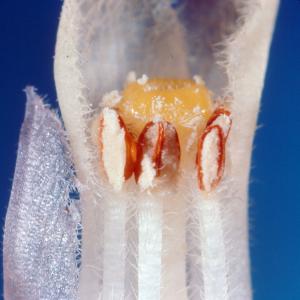
|
The stamens and stigma of Hemitomes, surrounded by petals. A sepal is at the left. The anthers are shedding pollen grains, which cling together in irregular groups rather than separate. The sticky nature of the pollen grains helps them adhere to hairs on an insect.
Return to the Hemitomes congestum page or the Parasitic Plant Index.
|
copyright: Carlquist, BSA
license: http://images.botany.org/index.html#license |
Image
|
Parasitic Plants

|

|
|
setSC-Hemitomes_congestum-8
|
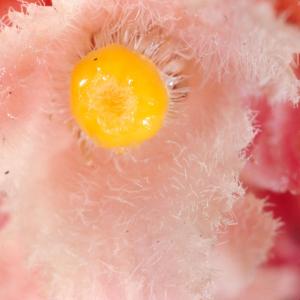
|
A flower of Hemitomes seen from above. The large yellow stigma is conspicuous. The very hairy nature of the inside surfaces of the petals is also evident. Why such a hairy flower? The hairs might keep small insects from climbing down into their flower and robbing the nectar. In that case, we would expect Hemitomes flowers to be pollinated by a long-tongued insect like a moth. The tongue of a moth could reach through the hairs down to the nectar at the bottom of the flower.
Return to the Hemitomes congestum page or the Parasitic Plant Index.
|
copyright: Carlquist, BSA
license: http://images.botany.org/index.html#license |
Image
|
Parasitic Plants

|

|
|
setSC-Hemitomes_congestum-9
|
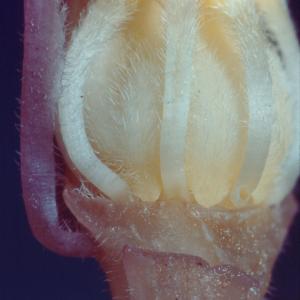
|
At the base of the flower of Hemitomes (two petals removed), one can see the knoblike nectaries between the hairy white stamen bases. The nectar secreted by these nectaries forms pools in the bases of the petals. A moth might be able to see the light colored flowers of Hemitomes even under relatively dark conditions.
Return to the Hemitomes congestum page or the Parasitic Plant Index.
|
copyright: Carlquist, BSA
license: http://images.botany.org/index.html#license |
Image
|
Parasitic Plants

|

|
|
setSC-Hydnora_africana-1
|
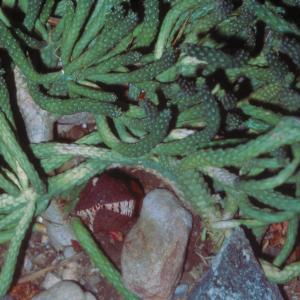
|
At first glace, this appears to be a picture of a green succulent, Euphorbia caput-medusae, viewed from above the plant--and it is. But next to the gray stone near the bottom of the photo is a brown flower. It belongs to a root parasite, Hydnora africana, which lives on the Euphorbia. Hydnora, from Africa, belongs to a family, Hydnoraceae that also includes a New World genus, Prosopanche. The relationships of this family were quite uncertain, but recent molecular data suggest that Hydnoraceae is a "basal angiosperm," among the more primitive of flowering plants. Parasites are often so highly modified, compared to their non-parasitic relatives, that their relationships are difficult to determine.
Return to the Hydnora africana page or the Parasitic Plant Index.
|
copyright: Carlquist, BSA
license: http://images.botany.org/index.html#license |
Image
|
Parasitic Plants

|

|
|
setSC-Hydnora_africana-11
|
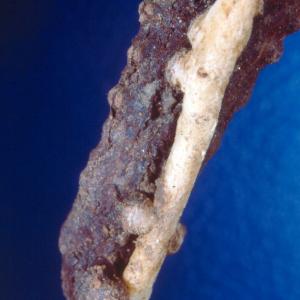
|
A root of Euphorbia (white) growing alongside a Hydnora root has been "captured" at several points. The Euphorbia roots form pad like structures. The contacts between the Hydnora and the Euphorbia are thereby widened. The Euphorbia furnishes Hydnora with moisture, food, and all other substances. Hydnora is not green and is completely dependant on a host plant. Succulent underground portions of the Hydnora, however, may fragment and stay alive for indefinite periods of time. Those fragments may at some time be able to contact a Euphorbia root and begin growth again.
Return to the Hydnora africana page or the Parasitic Plant Index.
|
copyright: Carlquist, BSA
license: http://images.botany.org/index.html#license |
Image
|
Parasitic Plants

|

|
|
setSC-Hydnora_africana-12
|
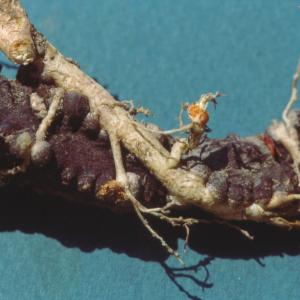
|
A Hydnora africana that has numerous contacts with a Euphorbia root. The nature of the underground axis (stem or root?) in Hydnora is not easy to determine with certainty, because there are no close relatives of Hydnora, and Hydnora is highly specialized for parasitism. However, there are reasons to favor the concept that the Hydnora axes are roots rather than stems. The growing tips show no evidence of reduced leaves at all, and there are no reduced leaves adjacent to the bases of the flowers. The five or six longitudinal rows of stubby roots on the axis remind one of patterns of lateral root formation on roots, whereas lateral roots that form on stems of plants don't tend to form neat longitudinal rows. And flowering plants other than Hydnora that are root parasites form roots (as in Orobanche), not underground stems, that interconnect with roots of host plants.
Return to the Hydnora africana page or the Parasitic Plant Index.
|
copyright: Carlquist, BSA
license: http://images.botany.org/index.html#license |
Image
|
Parasitic Plants

|

|
|
setSC-Hydnora_africana-2
|
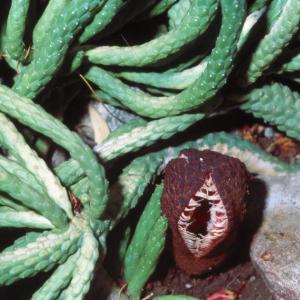
|
The only portion of Hydnora that appears above the ground surfaces is the upper portion of the flower. Much of the flower is below the soil surface. The flower is thick and succulent in texture. The portion of the flower above the ground surface is tubular and has three openings, one of which is shown here. There are three thick structures, which botanically should be called perianth segments, and which might be likened to sepals, that tend to stay united at the top of the flower.
Return to the Hydnora africana page or the Parasitic Plant Index.
|
copyright: Carlquist, BSA
license: http://images.botany.org/index.html#license |
Image
|
Parasitic Plants

|

|
|
setSC-Hydnora_africana-3
|
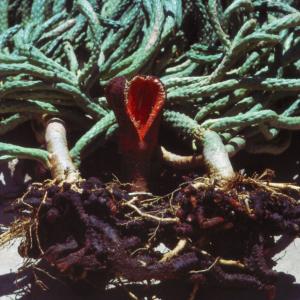
|
A plant of Hydnora and the two Euphorbia plants to which it is attached have been excavated and washed. This Hydnora plant is the only one ever known to have been cultivated. The seeds were collected in the Karroo Garden, Robertson, South Africa, by Sherwin Carlquist in 1973, and brought back in a fresh condition to his home in Claremont, California. He purchased several rooted cuttings of Euphorbia caput-medusae, a known host plant for Hydnora africana, removed the Euphorbia plants from their pots, lined the pots with Hydnora seeds, and put the Euphorbia plants back into their pots. During the next several years, the Euphorbia plants were repotted, but noting appeared to have occurred. The Euphorbia plants were planted into the ground. In 1979, a flower of Hydnora appeared. Apparently the development of a seedling of Hydnora is slow. Also, the development of the Hydnora may have accelerated when the plants of Euphorbia were planted into the ground and thereby enlarged in size beyond the size they had when potted. In this photograph, portions of two of the Euphorbia caput-medusae plants are shown. The roots of the Euphorbia are white, and thereby they are easily distinguished from those of the Hydnora, which are dark brown. The plant of Hydnora consists of thick succulent roots. Hydnora has no stems. The flowers of Hydnora are borne on the surfaces of the roots.
Return to the Hydnora africana page or the Parasitic Plant Index.
|
copyright: Carlquist, BSA
license: http://images.botany.org/index.html#license |
Image
|
Parasitic Plants

|

|
|
setSC-Hydnora_africana-4
|
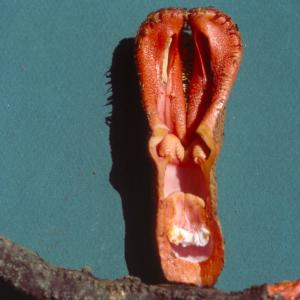
|
A longitudinal section of a flower of a flower of Hydnora africana from the cultivated plant. Notice that the flower is attached to the horizontal, knobby brown root (horizontal, at the bottom of the picture). At the top of the flower are two of the "sepals" (perianth segments) that can be seen above the surface of the ground. They are orange inside. Just below where these are joined is a short tube. At the top of the tube, one can see some yellowish-orange structures protruding into the tube. These are two of the three anther-groups. Hydnora flowers don't have stamens in the ordinary sense. There are groups of anthers united into bunches. At the bottom of the tube is a stigmatic area. The basal part of the flower has a cavity in it. At the top of the cavity are white ovules. The ovules will mature into seeds. The flower of Hydnora is a kind of intricate trap. Or, as we will see, a temporary trap.
Return to the Hydnora africana page or the Parasitic Plant Index.
|
copyright: Carlquist, BSA
license: http://images.botany.org/index.html#license |
Image
|
Parasitic Plants

|

|
|
setSC-Hydnora_africana-5
|
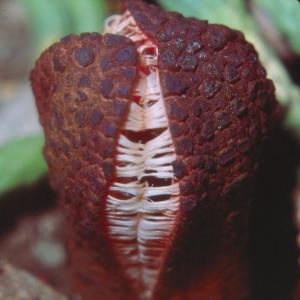
|
The flower of Hydnora, when it first opens, has white threadlike structures that cross the gap between the "sepals." The openings between these threads are barely large enough for a beetle to enter. More about that later! Although a beetle may enter a flower, it evidently has difficulty in finding its way out of the flower. This keeps it inside a flower long enough so that the beetle can pick up pollen or deposit pollen on its surface onto the stigmas at the bottom of the floral tube.
Return to the Hydnora africana page or the Parasitic Plant Index.
|
copyright: Carlquist, BSA
license: http://images.botany.org/index.html#license |
Image
|
Parasitic Plants

|

|
|
setSC-Hydnora_africana-6
|
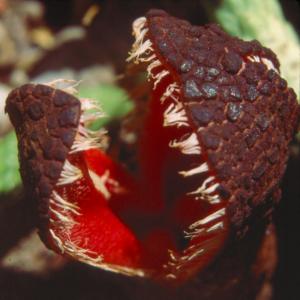
|
The threads that cross the gaps between the "sepals" of the Hydnora flower when the flower opens are pulled apart after a few days. Any beetles that entered the flower through those threads can now easily escape.
Return to the Hydnora africana page or the Parasitic Plant Index.
|
copyright: Carlquist, BSA
license: http://images.botany.org/index.html#license |
Image
|
Parasitic Plants

|

|
|
setSC-Hydnora_africana-7
|
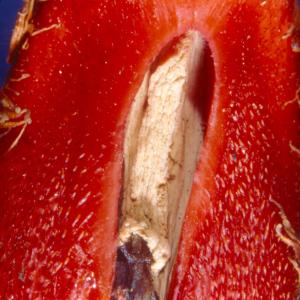
|
The inside of each of the three parianth segments (like sepals or petals) of Hydnora africana. Notice the bright organ color of these structures. On them are downwardly pointing hairs that are effective in directing beetles down into the lower portions of the flower, slowing the beetles from escaping from the flower. In this respect, Hydnora flowers are like the leaf of a pitcher plant (Sarracenia). The beetles are attracted to the flower of Hydnora by the scent emitted by the ivory-colored pad of tissue in the center. It emits an unpleasant dung-like odor. Not surprisingly, the beetles that are attracted are dung beetles. Even though this flower was on a plant cultivated in California, half a world away from where the plant is native in Africa, it attracted dung beetles. Very likely not the same kind of dung beetles as in Africa, but related. The pollination mechanism that occurs in the native habitat in Africa was thus duplicated, amazingly, in the cultivated plants.
Return to the Hydnora africana page or the Parasitic Plant Index.
|
copyright: Carlquist, BSA
license: http://images.botany.org/index.html#license |
Image
|
Parasitic Plants

|

|
|
setSC-Hydnora_africana-8
|
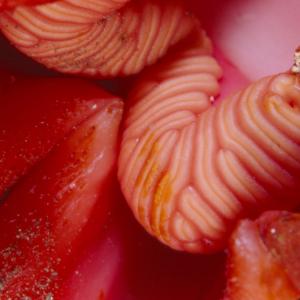
|
Here are two of the three anther-masses or anther groups of the Hydnora flower. They are arranged in a triangle; a gap between their pits permits beetles to fall down onto the stigma. The anther groups shown here have not yet released pollen. The stigmas of this flower are probably receptive at this time, however. Thus, beetles that have pollen on their bodies from an older flower would be able to brush some of that pollen onto the stigmas of this flower, achieving cross-pollination.
Return to the Hydnora africana page or the Parasitic Plant Index.
|
copyright: Carlquist, BSA
license: http://images.botany.org/index.html#license |
Image
|
Parasitic Plants

|

|
|
setSC-Hydnora_africana-9
|
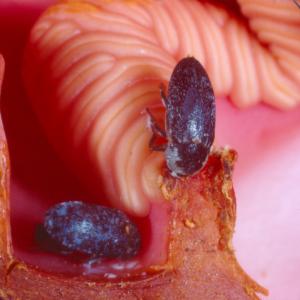
|
Here are the dung beetles that visited the Hydnora flowers of the plant cultivated in Claremont, California in 1979. Notice their bodies have some whitish hairs on them; pollen could adhere to these hairs. Flowers pollinated by beetles usually have some tissue that offers beetles as food. In Hydnora, that's the whitish tissue on the inside of the "sepals." But beetles don't confine their feeding to such special "bribe" tissues. Beetles eat pollen and then eat the cells of the stigma. Beetle-pollinated flowers usually have an abundance of pollen and an abundance of stigma areas, and Hydnora flowers are no exception. By producing excess pollen and stigma cells, beetle-pollinated flowers succeed in achieving pollination and producing seeds despite the feeding habits of the beetles.
Return to the Hydnora africana page or the Parasitic Plant Index.
|
copyright: Carlquist, BSA
license: http://images.botany.org/index.html#license |
Image
|
Parasitic Plants

|

|
|
setSC-Monotropsis_odorata-1
|
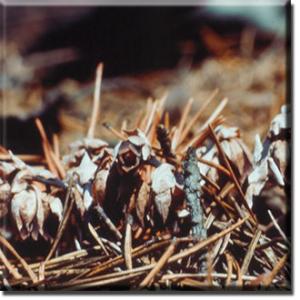
|
Monotropsis odorata, the Pygmy Pipes, is a small species of monotropoid that grows in pine woodlands of the southeastern US, mostly in the Appalachian Mountains. It occurs from Maryland south to Florida and east to Kentucky and Tennessee. This picture was taken by Dr. Gary Wallace in North Carolina.
Return to the Monotropsis odorata page or the Parasitic Plant Index.
|
copyright: Carlquist, BSA
license: http://images.botany.org/index.html#license |
Image
|
Parasitic Plants

|

|